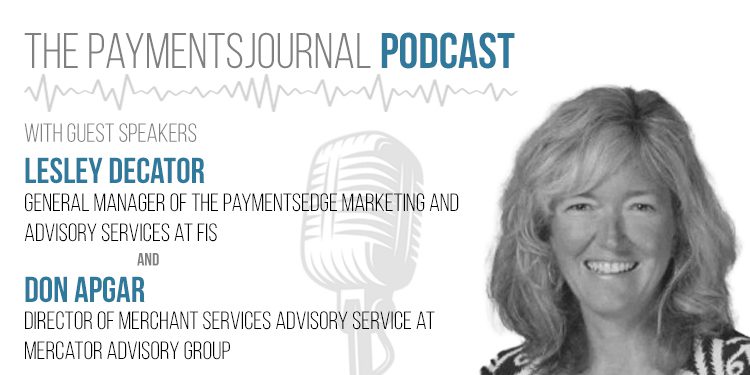For debit and credit card issuers, marketing has always been a pillar to growing the business: attracting new customers, activating those who have gone dormant, and finding incentives that increase business from active customers.
As happened with so many elements of consumers’ lives, the fundamentals of their engagement with card accounts shifted after the onset of the COVID-19 pandemic, requiring issuers to adjust their marketing approaches.
In this installment of the PaymentsJournal podcast, Lesley DeCator, General Manager of the PaymentsEdge Marketing and Advisory Services at FIS, and Don Apgar, Director of the Merchant Services Advisory Service at Mercator Advisory Group, discussed the current environment in marketing strategies, the importance of proper customer segmentation in campaigns, how the pandemic affected the offering of incentives, the use of communication channels to most effectively reach current and prospective customers, and extracting actionable intelligence from response rates and thus building a strong return on the marketing investment.
As DeCator noted, the pandemic certainly changed the spending environment—for example, debit and card-not-present transactions rose, consumers shopped extensively from home rather than in large groups in brick-and-mortar stores—but the underlying principles of marketing have proved durable.
“The basics are the same,” she said. “We need consistent communication, a very strong call to action, compelling incentives, and great cardholder service. The key to success is careful planning and timely execution. … And then you need to be able to pivot when situations change quickly, as they are prone to do.”
Building a Strong Marketing Campaign
The aim of PaymentsEdge, DeCator said, is to tailor marketing campaigns for clients based on the following foundation:
- Strong messaging
- A strong blending of the creative aspect of campaigning with cardholder response
- Low costs for clients so they can get the most from their marketing budgets
Here’s how those efforts played out vs. the results for FIS clients not using the PaymentsEdge advisory services for 2021 vs. 2020 in terms of growth:

The numbers are striking: spending growth for PaymentsEdge clients was 126% higher (23.31% vs. 10.31%), transaction growth was 23.7% higher, total active accounts growth was almost 109% higher, and total debit card growth was 177% higher.
While some issuers go it alone with their marketing campaigns and do an excellent job, DeCator said, others need help making sense of the results those campaigns generate and how to assess that information to further hone their approaches. She describes the PaymentsEdge service as “cradle to grave” in this respect, with the company continually testing its campaigns and messaging for efficacy and adjustments.
Apgar also noted the importance of keeping the marketing spending from negatively affecting the return on investment for card issuers.
“At the end of the day, if you’re spending a lot of money to deliver the results, you’re really adding a negative impact on the ROI,” he said. “Keeping the costs low, that denominator low, in the ROI equation is really important.”
The Importance of Segmentation
Segmenting a customer base for subsequent delivery of marketing messages is essential, DeCator said, noting that her group tests new segments and incentive groups throughout the year, with thorough vetting of a campaign before it gets included in the calendar.
In the debit sphere, targeting new inactives, long-term inactives, low users and mid-tier users, particularly within 90 days, drives the highest response and ROI, she said.
For credit card portfolios, a program that increases credit lines can allow for the growth of transactions and balances—“You can’t ask for additional spend if your cardholders don’t have any room”—and regular promotions for acquisitions, rate and use, balance transfers, and skip-pay campaigns also prove effective.
In the end, it’s about data aggregation, Apgar said.
“If you don’t have a good way of tracking ROI, even if you’re successful, you really don’t know why or where to invest additional resources and what to double down on and what to back off on,” he said.
Driving Use and Loyalty With Incentives
The pandemic “absolutely shifted” the approach of marketing to cardholders with incentives, DeCator said. The thrust of campaigns switched from travel and dine-in restaurants to shop-from-home experiences such as Amazon, Apple, Google Play, and Barnes & Noble, to name a few.
The pandemic also drove a shift in imagery. Marketing showed consumers shopping for and receiving goods in their homes, on their porches, and kicking back and watching a movie or playing a game in the comfort of their homes. Diversity in imagery, always a consideration, was also front and center, she said.
There were other effects, too.
“We had to change our baselines,” DeCator said, noting that the circumstances of the pandemic clouded whether a given card was useful or not to consumers. That forced her team to reach further back for historical data to guide decision-making.
“It was unprecedented. We were very successful, but it’s not an exercise we’re anxious to repeat.”
The pandemic, Apgar said, shined a light on the extent to which consumers are constantly evaluating their options for payments. The ability to harness data on consumer choices and habits and drive meaningful marketing toward them is paramount.
“Consumers are looking for leadership from the brands they do business with,” he said.
Channeling the Card Marketing Message
Here’s another shift as a result of the pandemic: PaymentsEdge is finding that in the post-COVID-19 environment, “most of our junk mail is in our [email] inbox.”
The best marketing approach with small to midsize clients, she said, is one that starts with direct mail and follows up with an email. For larger issuers, email remains the most cost-effective way of reaching customer segments.
As technology advances and new modes of communication kick in, it can be tempting, she said, to employ every possible means of getting a card user’s attention, such as through text messaging. But there are privacy concerns, she said, and testing continues before those campaigns are formally launched.
Said Apgar: “When you get too close to the consumer, it’s a little Orwellian. It’s a fine line.”










